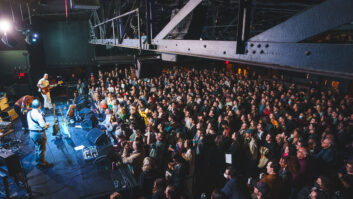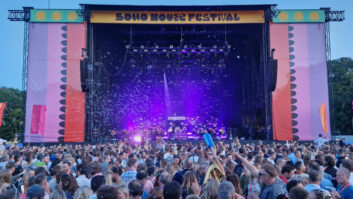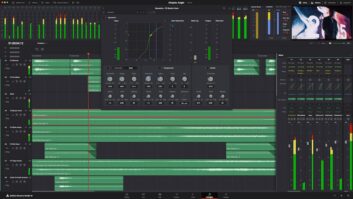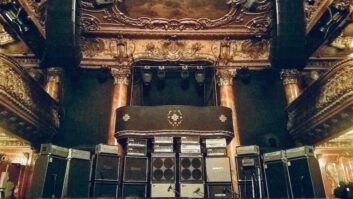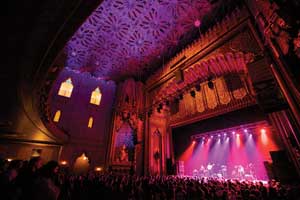
With the ongoing decline in physical music sales, the past couple of years have seen the spotlight shine on concert touring. Box-office numbers seem to rise year after year, driven in large part by megatours and high ticket prices. And artists are finding that, just like the old days, money is to be made on the road. While a lot of attention is given to the A-list acts and their monster stages, mid-level tours in mid-capacity venues are doing quite well, providing an outlet for a wealth of artists across all genres.
These 500- to 6,000-seaters aren’t quite clubs and they’re not quite arenas or sheds. They are performance spaces that have added sound and technology systems, making them attractive to promoters, artists and fans.
Mix
checked in with a number of these venues to look into their individual approaches to improving the concert experience.
The Fox Theater features a Meyer Sound system that complements the venue’s décor.
Photo: Josh Sanseri
The Fox Theater, Oakland, Calif.
Forty-three years after closing its doors as a movie palace, the Fox Theater — now the flagship live music venue for Another Planet Entertainment — reopened in February 2009 after an extensive $75 million renovation that includes a state-of-the-art performance space with a capacity of 1,500 to 2,800. Since its grand-opening concert with Social Distortion, this downtown Oakland venue has hosted such notable acts as Animal Collective, Sonic Youth, The Decemberists, The Shins and many others.
For the Fox Theater, the audio team (including stage manager Tony Leong) was cognizant of creating a system that would complement the renovation and décor, as well as be rider-friendly. “Our vision was to match the production aspect of the theater to the aesthetic quality,” says Leong. “The venue is so gorgeous that we had to make sure we did it right. The pristine nature of the restoration made us paranoid about anything we put up in the theater to the point where a typical black line array wasn’t going to cut it. The line array had to be painted. Luckily, Meyer Sound happened to be in our backyard. We spent an entire day looking at swatches of different colors up against our proscenium until we finally found a color that blends in seamlessly.
“If it seems a little vain that we spent an entire day on aesthetics, it probably is, but Another Planet Entertainment has had such a longstanding relationship with Meyer that we know what their gear is capable of, and, more importantly how accommodating their staff is,” he continues. “That’s been the beauty of our relationship. We’ve never felt that once they did the initial install, that was that. Our massive P.A. is the result of a few shows of trial and error. We initially had 11 flown MILOs per side, but our balcony is so deep that we realized we weren’t getting enough coverage up there, so we simply added another box. For our reserved-seated shows, sightlines weren’t as ideal as we’d hoped, so we swapped out the MICA stack for a smaller footprint of MSL-4s that were just as loud. Then we addressed our downstage coverage by adding three M’elodies. It’s been an evolving process for us, but we are very happy with the results of our system. We are fully capable of, and are comfortable, handling arena-sized production [such as the ‘secret’ Green Day concert the Fox hosted in April], as well as smaller events like the graduation for the Oakland School of Arts, which is located next door.”
Because the types and scope of performances at the Fox vary, Leong says the best decision was to supply house racks and stacks and bring in control on a per-show basis. “Half of the shows we’ve had so far bring full production anyway, and everyone is so picky with consoles that it wasn’t worth it to us to buy,” he explains. Local sound company UltraSound/Pro Media provides the “house” console package, which includes a Midas H3000 (FOH) and Yamaha PM5D (monitors), which can be brought in easily when bands don’t bring their own boards. The P.A. is all Meyer, including 12 flown MILOs per side (custom-painted), a center cluster of three custom-painted 700-HP subs flown, and four MSL-4s and six 700-HPs ground-stacked on each side of the stage. “Originally, we had the MICA line arrays stacked on each side of the stage next to the subs, but they ate up too much real estate and created sightline issues, yet the MSL-4s fit in just perfectly.”

Carlos Santana performs at The Joint, which features a d&b array.
Photo: Erik Kabik/Retna
The Joint at the Hard Rock Hotel, Las Vegas
A fixture on the Strip’s music scene, The Joint at the Hard Rock Hotel and Casino has been rebuilt, doubling its former size to a 4,000-seat capacity. The venue is a must-play for touring artists, as well as “stay for a while” residency acts such as Carlos Santana, who has booked out the venue for his performances in August/September 2009. Other uses of the multipurpose facility include sporting events (such as boxing) and banquets.
When the Hard Rock Hotel decided to reopen The Joint a few years back, they called on Sceno Plus of Montreal to handle the audio/visual install. Sceno Plus, in turn, hired Solotech to do the package, which brought in Francois Desjardins to oversee the installation of the audio portion. Audio equipment selections were made by the Hard Rock staff, who looked at touring riders and oft-used gear. At that point, Desjardins says of his role, “I was grabbing the specs that other people designed and made sure that everything worked correctly: commissioning all the speakers and the consoles, making sure that the speakers and the consoles and the processors talked.
“More than 20 years ago, we used S4s, and they were not really as efficient as today’s loudpseakers,” continues Desjardins, who was Celine Dion’s front-of-house engineer for her last tour. “Today, you have smaller speakers and they are really efficient. It’s amazing how much power you can put out of that little box. And everyone is trying to build smaller and lighter speakers, and you end up having a lot of power in a small space. There’s a fine line between ‘arena’ product and ‘theater-sized’ product.”
The venue also has a full-time audio engineer, Nick Simon, who can be called upon for mixing duties or, as with a recent Bon Jovi show to assist the band’s engineer and make sure all goes smoothly.
As most of the monitor and FOH package was put together at Solotech in Las Vegas, and the racks installed by Conti Electric under the supervision of Bill Famini, Desjardins says that this was a seamless install, a statement not to be taken lightly, considering he’s been involved in many different projects in Las Vegas for the past seven years.
“You’re usually at soundcheck and somebody’s grinding something behind you,” he says with a laugh. “We had no issues except for human errors. We also had great support from the two major suppliers — d&b and Digidesign — which helped make for an easy installation.” Taking the spec’d audio gear list from Hard Rock Hotel, Desjardins oversaw the rigging of a d&b array, which comprises J-8, J-12 and J-SUB for the mains; E-3 for under-balcony delays and front-fills; and Q-10 for house delay and near-fields. Digidesign Profile boards were selected for both FOH and monitors. Control is via BSS’ London BLU Series. Sceno Plus specified the acoustical treatment, which Desjardins says is pretty basic but efficient. “There are some diffuser/absorbers around the mezzanine and balcony edge,” he describes. “They also treated the ceiling with some dense acoustical absorbers. The result is quite interesting.
“The choice of the components and the quantity make this room perfect for almost any application,” he continues. “If you are running out of power, well, the problem might be somewhere else. Also, the system is fully digital. You convert onstage at the mic preamp on the console and the signal is converted back to analog at the output of the d&b amplifiers.”
Popejoy Hall Center for the Arts, Albuquerque, N.M.

The JBL Vertec system at Popejoy Hall can be “detached” for use outside of the venue.
The Popejoy Hall Center for the Arts is located on the University of New Mexico campus and brings in touring Broadway shows, national/international artists, the New Mexico Symphony Orchestra, and performances by the UNM Department of Music and the Albuquerque Youth Symphony.
When spec’ing the system, technical director Billy Tubb had to make sure that it was not only flexible and could provide 5.1 for opera simulcast or films, but it also had to be “detachable” so that it could be rented to local production companies. “We added extra cables to the package, and I also designed both of the onstage equipment racks that provide power, signal and data distribution to be identical so that the system can be split into two or even four separate systems,” Tubb says.
Tubb also needed to consider the space’s functionality when selecting gear. “I really wanted to use stage monitors as the surround speakers for the 5.1 setup so that we could kill two birds with one stone,” he explains. “The JBL VP7212MDP was not designed for wall mounting, yet the JBL custom shop added multiple rigging points, allowing us to basically add 16 new wedges to our inventory. When we need them for the 5.1 setup, we add the custom adjustable angle brackets my installer built and hang them. They actually fit snugly right against the wall and look like they were meant to be there. They also sound better than most of the traditional low-profile speakers we would have considered for the location and coverage needed.” Taking versatility a step further, the custom shop installed a pole-mount socket on one end of the VP7212MDPs.
The rest of the system is all JBL VerTec: “Honestly, VerTec was not a system I originally considered after having heard an early version of the product. And the full-sized box was just too big for us in regards to sightlines at our venue,” Tubb explains. “Then the following events happened: JBL introduced the mid-sized VT4888 and developed their new Version 4 DSP presets, which has greatly improved the sound of the boxes. Now, VerTec has become more accepted on technical riders. The DrivePack technology makes it a self-powered system, while the networking, control and user features providd by Harman’s System Architect software interface are very power.” Rounding out the gear is a Midas Heritage 2000 console. On the acoustic front, the rear of the orchestra has 4-foot alternating sections of cherry-stained wood diffusers and fabric-covered 2-inch absorption panels. Scheduled for installation this month are more wood diffusers on the balcony rail.

An Outline Butterfly system brings the stage sound to a small audience at the Pacey Richards Theater.
PC Richards Theater, New York City
Inside the AT&T building in Manhattan (where Clear Channel Radio houses a number of its New York radio stations) sits the new PC Richards Theater, a 200-invite-only room that was designed as an intimate performance space. There is also a separate mixing room to allow tracking or live mixing of the show for broadcast or digital media content generation.
Though its scope generally includes acoustical design, for this project, SIA Acoustics was employed to handle the technical system only, says Steve Sockey, who headed the SIA project team. After meeting with Josh Hadden, Clear Channel radio director of engineering and IT, and his team, SIA created a technical design that would fulfill the theater’s variety of goals. “This is an exclusive type of venue with A-level artists coming in,” Sockey says. “You have substantial technical demands that typically come with major talent: monitor console, house console, enough stage monitors, a large enough stage, significant mic inventory, in-ear monitors and wireless mics. We wanted to provide systems that made sense, were highly functional and robust, and had great rider acceptance on all fronts. We felt it was critical for the infrastructure — while being comprehensive to facilitate any type of performance — to be logical to allow an operator to walk in and quickly become acclimated. As a designer, you have to decide what’s important, and for us it’s the functionality.”
While a small room, the theater packs in a large amount of gear, including two Digidesign Profiles and a Digidesign ICON Pro Tools systems in the mixing space. To preserve complete independence between the various live and recording systems, all field connections terminate in control room patchbays, and Jensen transformer-isolated splitters provide FOH, monitor and recording systems with duplicate signals. “From the control room,” Sockey says, “they can reconfigure the room as needed. A large number of tie panels are located throughout the facility, and any routing is possible via the patchbays. Having said that, the patchbays are normalled to allow someone to remove each patch cable and be show-ready for what the client has defined as their ‘default’ configuration.”
For the live sound system, Outline C.D.H. 483 “Butterfly” main arrays were selected due to their consistent directivity, compact physical packaging and high-power output. Outline MiniCompass systems are used as delay speakers and surround speakers. A number of high-capacity suspension points are located throughout. Each of the loudspeaker arrays is suspended via CM-ET Prostar chain motors to allow easy reconfiguration and achieve the maximum possible trim height. “This is a sound system that will readily accomodate rock ‘n’ roll performances, but where a completely clean look is needed [i.e., a video shoot], they can quickly take it down and put it away,” Sockey explains. The amplifiers are mounted to the Butterfly arrays via custom frames (designed by McLaren Engineering) to eliminate the need for amp racks.
“This system provides very sophisticated capabilities in an extremely compact footprint. Because of significant advances in technology, the difference between arenas and small theaters, or between dedicated studios and multipurpose spaces, has really become one of scale and not quality,” Sockey says. “This space has the same preamps, converters, consoles, loudspeakers, amplifiers, et cetera, as a larger venue — and though it may have fewer of them, the level of production is the same.”



